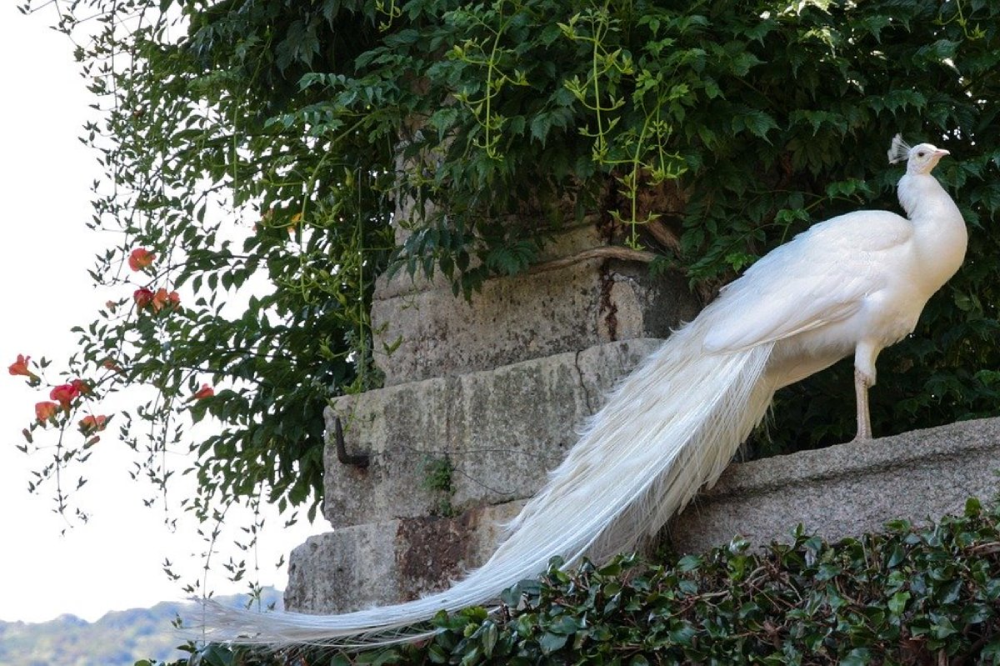The white peacock, an ethereal and captivating creature, stands as one of nature’s most stunning and rare spectacles. It is revered across various cultures and admired for its striking beauty. The white peacock, scientifically known as Pavo cristatus, is a symbol of grace, mystery, and elegance. Unlike the commonly known Indian Blue Peafowl, the white peacock is a genetic variant of the same species. It is exhibiting a unique and enchanting appearance that has fascinated humans for centuries.
Origin and Genetics
White peacocks are not a separate species but a color variant of the Indian Peafowl. The distinctive white coloration results from a genetic condition called leucism, which leads to a reduction in all types of skin pigment, distinct from albinism, which is characterized by the absence of melanin only. While albinism results in pink or red eyes, leucistic animals, including white peacocks, retain their normal eye color.
The genetic anomaly causing leucism in white peacocks means that these birds lack the usual pigmentation in their feathers, leading to their striking white plumage. Despite their different appearance, they share the same behaviors, mating rituals, and vocalizations as their more colorful counterparts.
Appearance
The white peacock is renowned for its dazzling white feathers, which glisten in the sunlight, creating an almost otherworldly spectacle. The male white peacock, or peacock, is especially known for its extravagant tail, or train, which it fans out during courtship displays. This train can reach up to six feet in length and is adorned with iridescent “eye” patterns, similar to the traditional blue peafowl but subtly shimmering in shades of white and silver.
The female, known as the peahen, while less ostentatious, also boasts a charming appearance with her soft white feathers. Both genders have the same structural features, including a crest atop their heads and a robust body, but it is the male’s courtship display that captivates the observer’s imagination.

Habitat and Distribution
Native to the Indian subcontinent, peafowl have been domesticated and are now found in various parts of the world. White peacocks, due to their striking appearance, are often found in aviaries, zoos, and private collections. So, they are not commonly seen in the wild. Their natural habitat includes deciduous forests, grasslands, and areas with plenty of cover and food sources.
In the wild, these birds are ground feeders and primarily consume seeds, insects, and small creatures. Their ability to fly is limited and usually reserved for escaping predators or roosting in trees at night.
Symbolism and Cultural Significance
Throughout history, the white peacock has been imbued with rich symbolism and cultural significance. In many cultures, these birds are considered omens of good luck, purity, and prosperity. In Hindu mythology, the peacock is associated with various deities and is considered sacred. The white peacock, in particular, symbolizes the divine and the ethereal, often representing peace, spirituality, and resurrection.
In Western cultures, the white peacock’s beauty and rarity have made it a symbol of nobility and grace. It has been depicted in various forms of art, literature, and folklore, often as a creature of exceptional purity and splendor.
Breeding and Conservation
Breeding white peacocks can be challenging due to the specific genetic conditions required to produce leucistic offspring. Breeders must carefully select mating pairs to ensure the preservation of the white coloration. That can make these birds quite rare and valuable.
Conservation efforts for peafowl, in general, focus on preserving their natural habitats and ensuring sustainable populations. While white peacocks are often protected in captivity, their survival hinges on the broader conservation of peafowl species and their ecosystems.
Fascination and Popularity
The allure of the white peacock extends beyond its physical beauty. These birds have captivated the hearts and minds of people across the globe. Their rare and elegant appearance makes them a popular choice for ornamental purposes in estates, gardens, and parks. Additionally, white peacocks have found their way into modern popular culture, appearing in films, books, and fashion, further cementing their status as symbols of beauty and elegance.
Conclusion
The white peacock remains one of nature’s most breathtaking marvels. Its exquisite appearance, rich cultural significance, and the fascinating genetic origins behind its stunning white plumage all contribute to its enduring allure. As both a natural wonder and a symbol of purity and grace, the white peacock continues to inspire awe and admiration in all who encounter its beauty. Whether in the wild, in captivity, or as a motif in human culture, the white peacock stands as a testament to the diversity and splendor of the natural world.









